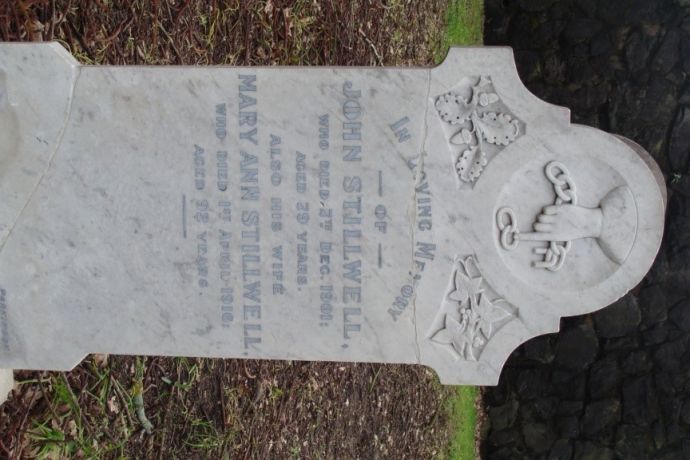AWA: Academic Writing at Auckland
Title: Analysing Iconography: The Chain
|
Copyright: Imogen Allan
|
Description: Select an image from a gravestone ...and analyse its meaning. ...This project is intended to help you to find out about the symbolic meaning of visual images, using research tools, but also thinking independently about how meaning is modified by a specific context. ...explain clearly what the origins and general meaning of your symbol might be ...Then analyse the meaning of the symbol in the specific context of whom the gravestone commemorated (for instance, a soldier, wife, child, etc.).
Warning: This paper cannot be copied and used in your own assignment; this is plagiarism. Copied sections will be identified by Turnitin and penalties will apply. Please refer to the University's Academic Integrity resource and policies on Academic Integrity and Copyright.
Analysing Iconography: The Chain
|
General Meaning of the Symbol The chain can have both positive and negative connotations. On the one hand, because of its practical uses, it is a symbol of imprisonment, slavery and defeat. In the religious context of the Bible, Lucifer falls into the abyss wrapped in chains.[1] On the other hand, chains, when broken, reference liberation. Again in the Bible, chains restrained St. Peter until he was set free by an angel.[2] This story offers further symbolism, for broken chains represent the divine enlightenment and salvation that St. Peter achieved when released. Chains also feature in the writings of Homer, for in neo-platonic times a golden chain was believed to link heaven and earth or creature and creator.[3] Chains are further attributed to gods, who bind all, and have power over life and death, “ensnaring the guilty and freeing the just”.[4] Chains, such as mayoral chains, represent order or office, the bond of marriage,[5] and are used as Christmas decorations suggesting social family unity.[6] In representing the links of a freemason handshake, and because of its physical properties, the chain also symbolises unity and strength.[7] Meaning of the symbol on this particular gravestone On the gravestone the chain is held by a descending hand. The index finger points to two links which have fallen from the chain but are still bound together. This calls on the interpretation of a chain as a symbol of marriage, for buried in this grave are husband and wife, John and Mary Ann Stillwell. The two fallen links represent the deceased being still bound together after death, suggesting a strong marriage, the links also representing unity and strength. Furthermore the two links resemble wedding rings entwined together. In addition, this particular representation suggests the deceased have been set free from the bonds of mortal existence by divine intervention, in the form of the hand descending from heaven, implying the Stillwells were Christian. The broken chain also indicates they were good and just, as only the just are set free in chain symbolism (e.g. St. Peter not Lucifer). Lastly there is a possibility of a military connection as a chain has connotations of office and the gravestone also depicts acorns and oak leaves, a common symbol found on the graves of those in the military.[8] Bibliography Biedermann, Hans. Dictionary of Symbolism: Cultural Icons and the meanings behind them. New York, Oxford: Fact and File, 1992. Cooper, J.C. An Illustrated Encyclopaedia of traditional symbols. London: Thames and Hudson, 1978. Tressider, Jack. The Complete Dictionary of Symbols. San Francisco: Chronicle Books, 2005. Shepard, Rowena and Rupert. 1000 Symbols: What Shapes Mean in Art and Myth. New York: Thames and Hudson, 2002.
The gravestone of John and Mary Stillwell, Symonds Street Cemetery.
[1] Hans Biedermann, Dictionary of Symbolism: Cultural Icons and the Meanings Behind Them (New York, Oxford: Fact and file, 1992), 63. [2] Rowena and Rupert Shepard, 1000 Symbols: What Shapes mean in art and myth (New York: Thames and Hudson, 2002), 308. [3] Hans Biedermann, Dictionary of Symbolism: Cultural Icons and the Meanings Behind Them (New York, Oxford: Fact and file, 1992), 64. [4] J.C. Cooper, An Illustrated Encyclopaedia of Traditional Symbols (London: Thames and Hudson, 1978), 22. [5] Ibid, 32. [6] Jack Tresidder, The Complete Dictionary of Symbols (San Francisco: Chronicle Books, 2005), 95. [7] Ibid, 115. [8] Hans Biedermann, Dictionary of Symbolism: Cultural Icons and the Meanings Behind Them (New York, Oxford: Fact and file, 1992), 243. |


